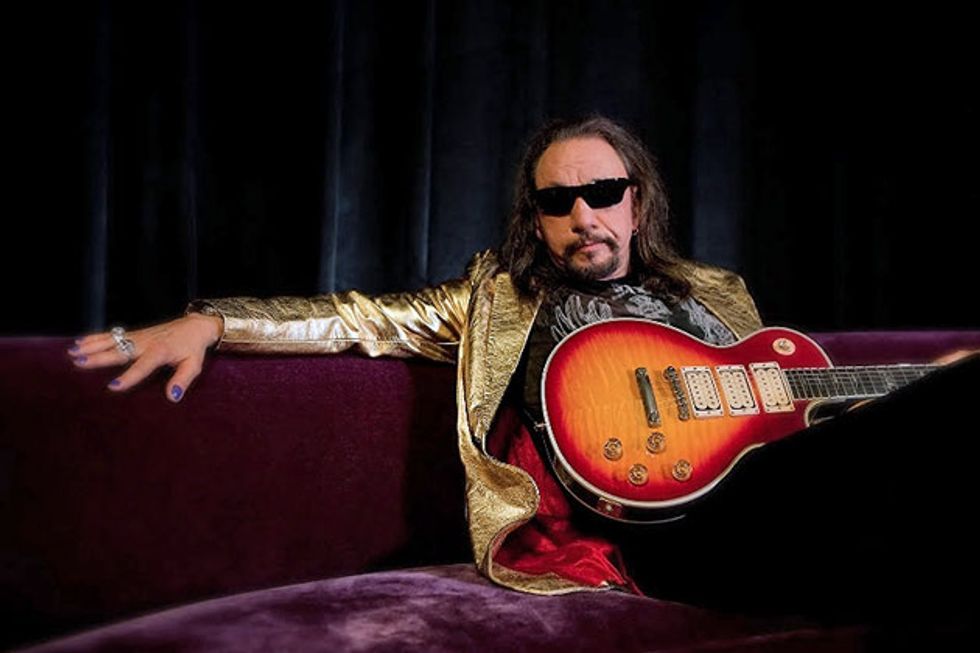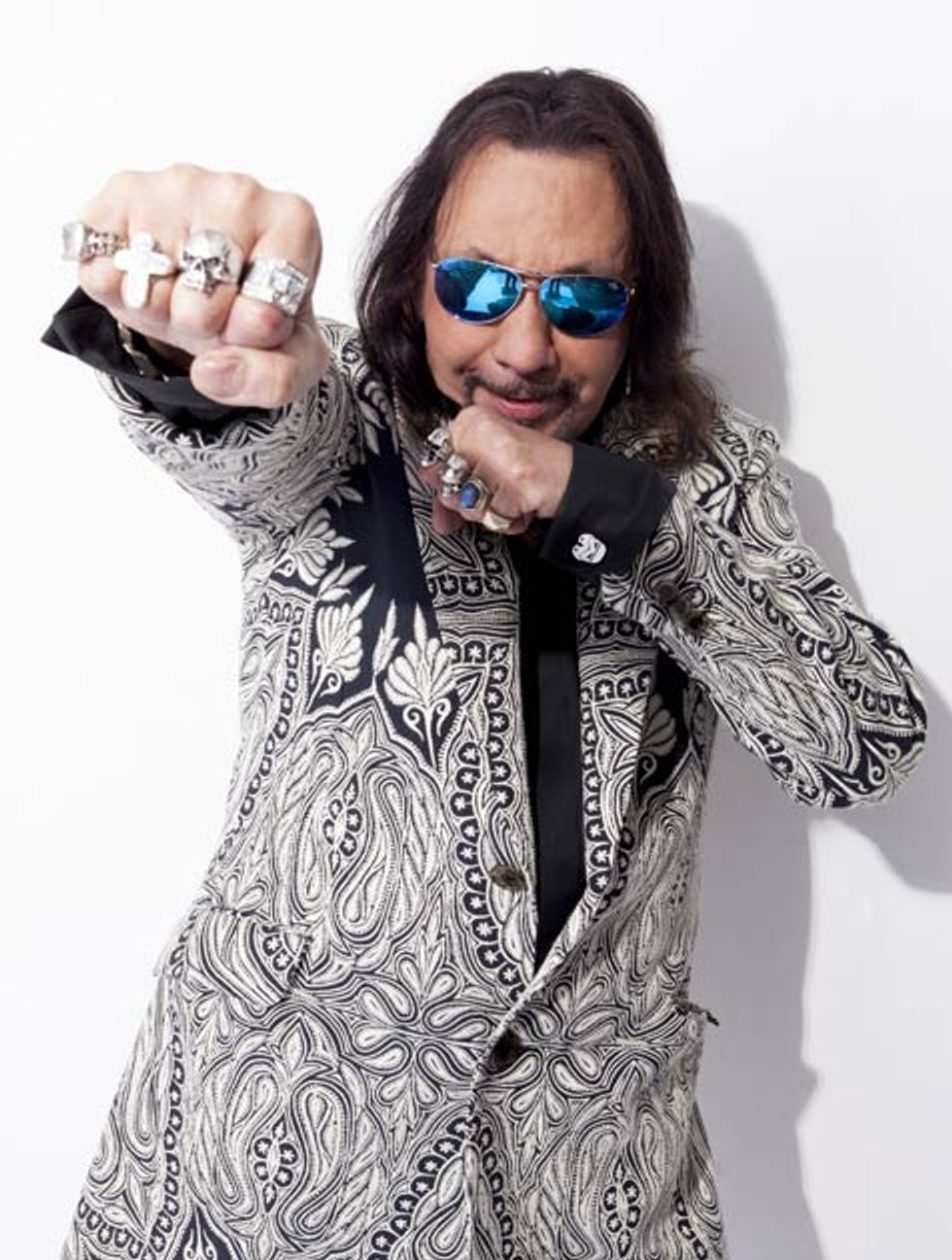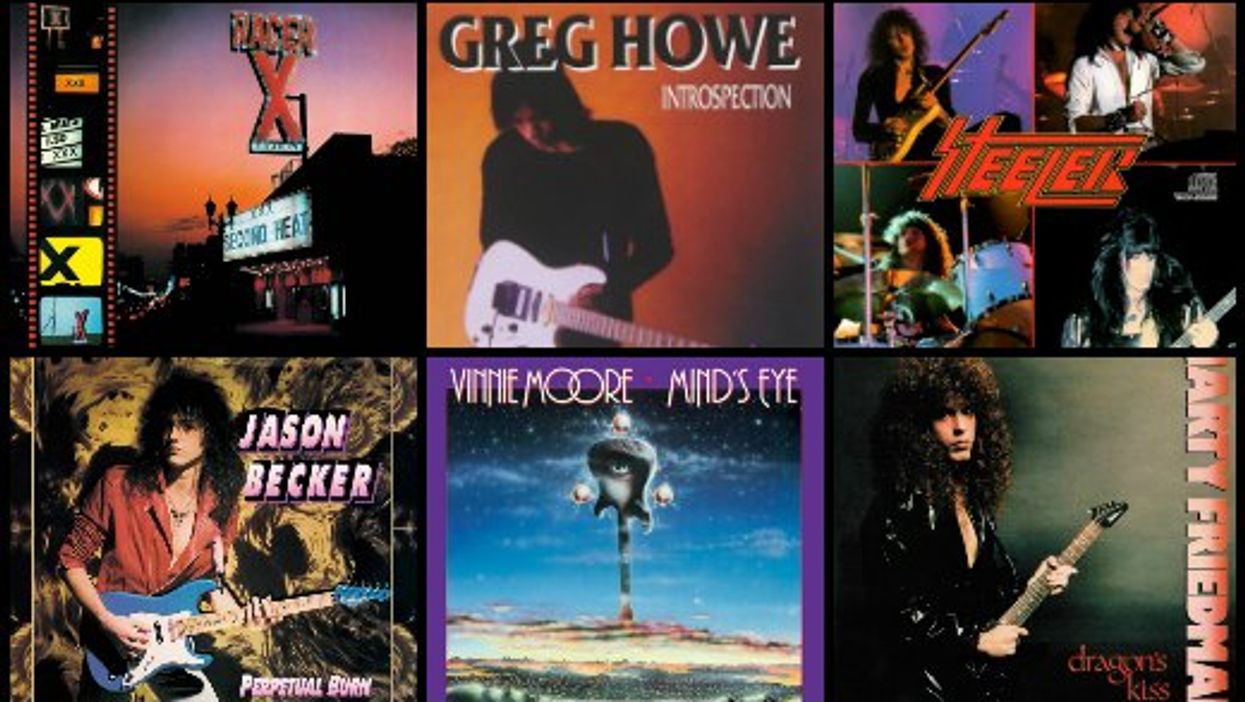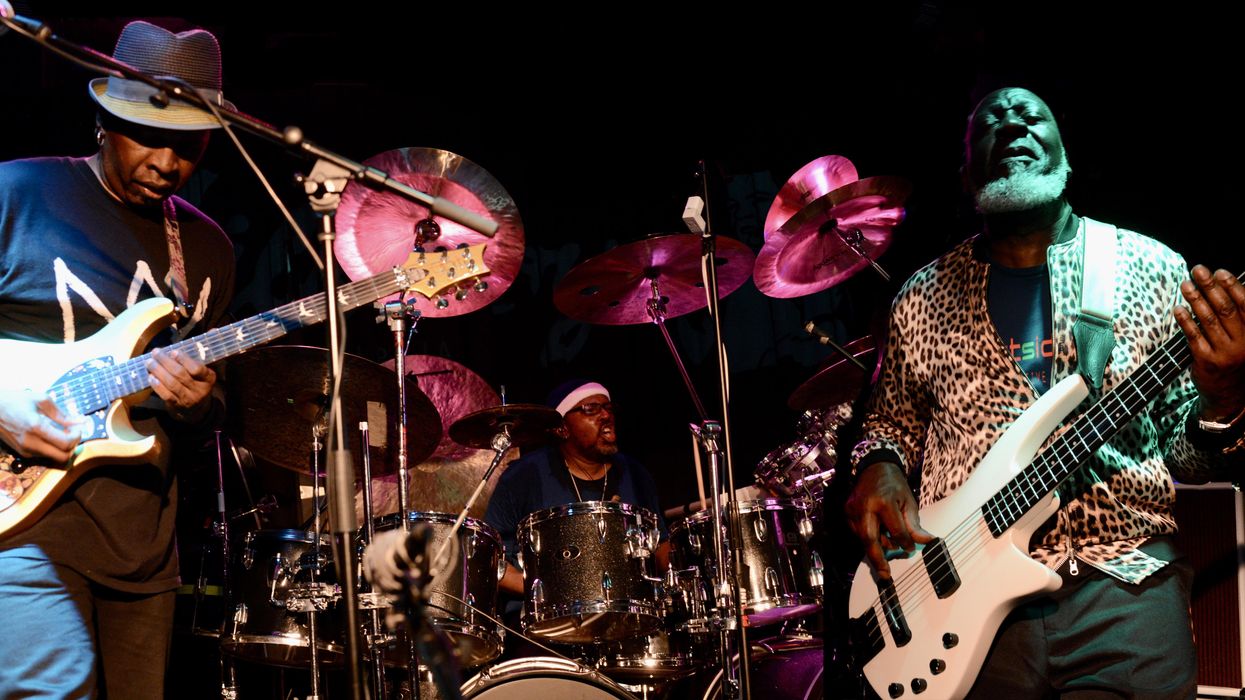One fateful day in 1973, Ace Frehley showed up wearing mismatched orange and red sneakers to audition for a band seeking a “hard rock guitarist with balls and flash.” After hauling his 50-watt Marshall and 8x10 cab up a long flight of stairs and jamming on “Deuce,” Frehley landed the gig. Before long, the band became Kiss, one of the all-time giants in rock history.
As a founding member of Kiss, Frehley has lived a life that intertwined rock ’n’ roll excess with perpetual drama that continues to this day. While Kiss ruled the music scene during the mid ’70s, by the start of the ’80s, amid plenty of mudslinging, Frehley, drummer Peter Criss, and manager Bill Aucoin parted ways with the band.
It took 15 years for the original members of Kiss to reunite for a performance on MTV Unplugged. This appearance led to a successful reunion tour, as well as the recording of Psycho Circus, which featured all four original Kiss members together for the first time since 1979 (though Frehley ended up playing on only two songs, with the others being performed by studio musicians).
some songs on the record.”
Earlier this year, the pot was stirred up yet again. Kiss was finally inducted into the Rock and Roll Hall of Fame and, as to be expected, controversy ensued. After initial talks of an original band reunion, Kiss gatekeepers Gene Simmons and Paul Stanley ultimately decided they wanted to perform as Kiss with their current lineup featuring Tommy Thayer and Eric Singer, rather than Frehley and Criss. Flamewars erupted all over the interweb, and ultimately Kiss ended up not performing at all during the ceremony. While fans were disappointed with the RRHF debacle, the timing couldn’t have been better for Frehley, who recently dropped his latest release, Space Invader, with a buzz still in the air.
“It’s working to my benefit,” says Frehley. “I started the record last July and then I found out about the Rock and Roll Hall of Fame induction right after the new year. I did the Jimmy Fallon show last night, and a lot of good things are coming up in the future—knock on wood.”
Premier Guitar caught up with Frehley in his suite at the W Hotel in New York’s Times Square where he discussed making the new record, his approach to layering multiple guitar parts, his current gear goods, and what lies ahead.
How was The Tonight Show with Jimmy Fallon?
It was great. I’ve known Kirk [“Captain” Kirk Douglas], the guitar player, for several years. It was just perfect timing, you know? Jimmy was great, and his crew was great. I had a lot of fun.
Did you rehearse beforehand?
We went over six songs. It’s nice, they recorded the rehearsals, and I’m wearing earphones, so right before we were going to play a song, I’d get a preview of it. It’s better living through technology [laughs].
Why didn’t you participate in the ALS Ice Bucket Challenge and pour ice-cold water on your head with those guys on the show?
Thank god they excluded me from that. I really didn’t want to take part in it because I didn’t bring a change of clothes with me.
What inspired Space Invader?
Well, for the last couple of years, I was being courted by a couple of different labels, and I finally settled on eOne. I’m really happy—it’s been a great marriage so far.
How long did it take to make Space Invader? I went into the studio last July and the whole process took about 10 months. I did a lot of the engineering at home. My engineer from New York flew to my home studio in San Diego, and we did overdubs there. Most of the basic tracks were cut in Turlock, California, at my friend Matt Swanson’s studio, The Creation Lab. That’s kind of in a farming community, about 10 or 15 minutes south of Modesto, where they shot American Graffiti. It’s a great place for me because I have Attention Deficit Disorder, and there’s not much to do there. No distractions—just me, my drummer Matt Starr, and an engineer. I’m real happy with the end result.
Ace Frehley prefers to use plug-ins when recording because of the flexibility they offer in the mixing process. “If you record the effect into the mic, you can’t get rid of it,” he says.
“Toys” starts off with massive layers of guitars. Talk us through how you build up a sound like that.
I use the same formula that I started using in 1978 with [drummer] Anton Fig and [legendary producer] Eddie Kramer on my first solo album, Ace Frehley. First we cut basic tracks—drums and rhythm guitar. Once we decide on which track we like, I’ll overdub a scratch bass. Then we have the foundation for a song and you start overdubbing. Some of the songs don’t sound like they have that many guitars, but there are a lot of layered guitars that are tucked. I double or triple everything. You know, some of them have 10 or 12 guitar tracks. But a lot of them are tucked low and subtly used to boost certain parts. I like to do octave parts. Something I did with Paul Stanley back in the ’70s was if he was playing a low part, I’d play the inversion of it. That way you get a much thicker sound.
For the multiple parts, would you use the same gear setup?
I’d vary the guitars. Most of the stuff I track with a Les Paul. Then, a lot of times I’ll double stuff up with Fenders because they have a different sound. So you blend the two sounds together. Live, I exclusively use Gibson Les Pauls, but in the studio I use a variety. If you listen to the early Who records, Pete Townshend used a lot of acoustics tucked under the electric guitars. That’s something I learned from Pete, and I incorporate it on some songs on the record.
Your tone changes in the middle of the solo on “Starship.” After one phrase, it sounded like the next phrase entered using a different setup.
Different guitar, different amp setups. That’s the beauty of Pro Tools and digital editing. We did it section-by-section. That’s why there are so many varied parts in that song. That song calls for it. It’s the premier instrumental on the record. I think it’s great the way it goes through different genres of sound.
When you covered Hello’s “New York Groove” on your first solo album back in the day, it reached No. 13 on the Billboard Hot 100, and was the highest charting single of any Kiss member’s solo albums. What inspired you to cover Steve Miller’s “The Joker” on the new album?
That was eOne Music’s idea. I was a little resistant because I didn’t think the song was, maybe, heavy enough, in respect to the other songs on the record. But I think I made it my own and heavied it up. I put a rockin’ solo on it. I also gave it a “New York Groove” kind of swing on the choruses and rhythm.
The solo in “The Joker” has a lot of power. How do you conjure up that energy in a studio environment?
I empty my head, know what key I’m playing in, and just go. Obviously, I’d get the tone first and get the levels right, working with an engineer. Some of the stuff I engineered myself, but I would say that for 90 percent of the solos, I worked with an engineer. I like to free myself up from the task of worrying about levels and buttons and whatnot.
Ace Frehley's Gear
Guitars
Gibson Custom Ace Frehley Signature Les Paul
Gibson Custom Ace Frehley “Budokan” Les Paul
Fender Stratocaster
Amps
Marshall JCM900
Marshall JCM2000
Bad Cat 1x12
Effects
Zoom G3
Strings and Picks
Gibson strings (010–.046)
Medium to heavy picks
How many takes would you typically do?
I usually do about five or six takes. We’ll listen to them and a lot of times we’ll take the front end of one solo, the middle part of another, and the tail end of another. People have been doing that for years. I’m not gonna cop to the idea that I do a solo from beginning to end flawlessly. Very few people do that these days. Sometimes I’ll do a composite solo of three or four takes, and memorize and double it. Sometimes that comes out better than the actual edited composite. Sometimes I’ll favor the original and have the doubling of the composite solo tucked under.
Then you’d have to relearn what you improvised. Is that pretty hard to do?
Depends on how complicated it is. The real fast stuff I do, yeah, sometimes it takes a little patience. Because most of the stuff I play, right after I play it, I forget it.
I understand you wrote “Inside the Vortex” on bass.
Yeah. You’re doing your homework. I wrote that on my old sunburst Fender Precision. It’s actually the same bass I used on my ’78 solo record. I was fooling around with it and going through a distortion unit and an envelope filter, and I just came up with that riff and then I built the song around that.
That riff has a lot of stops and starts. Is that the bass influence?
It’s a little Led Zeppelin-esque. I like the direction it goes in and where it takes you.
Tell us more about the guitars you used on the album.
Mostly Les Pauls, but like I said, to double up parts, I’d use some Strats. I also used a big load of Gibson acoustics, some Guilds, Taylors, and a couple of Dobros. Stuff that I collected over the years. Live, I still favor my AFS [Ace Frehley Signature] Les Paul. Those are still my favorite guitars made by Gibson Custom. The “Budokan” is a real close second.
Why is that?
I don’t know [laughs]. When you play ’em, you’ll know. They just kill. I’m trying to figure out what my next model will be. I’m talking about possibly putting out a tobacco sunburst Standard, which was the first Les Paul I used with Kiss, or maybe the black triple-pickup. I should take a poll and see which one wins.
How close is the signature “Budokan” Les Paul to your actual model?
I can’t tell the difference.
Do the middle pickups in your Les Pauls ever get in the way?
I keep the rhythm and middle pickups really low. You know why? Because they’re disconnected. My tone is the treble pickup—usually a DiMarzio Super Distortion. I like Duncans too.
For some reason, I thought you had a signature pickup.
No, I don’t. I should have one. I just never got around to it. I should get together with either Larry or Seymour, and come up with an Ace pickup. I am working on a travel guitar that I think is gonna be good.
Can you give us some details on it?
I can’t talk about it yet. I’ve been playing with a bunch of different prototypes, and it’ll be coming out soon. Just trying to figure out who will make it. It’s for the traveling musician—something that doesn’t take up a lot of space. There’s a bunch of them out there, but I don’t think there’s anything that really sounds great.
Do you have any string preferences?
For a while, I exclusively used Gibson .009–.046 sets, but for the last couple of tours, I’ve been using heavier strings. I’m using .010s now. When I’m in the studio, I’ll string up guitars all sorts of different ways. Sometimes I’ll have super-light strings on one Les Paul, mediums on another, and then heavy ones on a third Les Paul. Obviously, the heavy ones I’m gonna use for a rhythm track, and the thinner ones are for a lead track where I’ll do a lot of bending. So it gives me a lot of flexibility.
Sometimes I’ll also vary the thickness of my picks. I usually use mediums, but sometimes I’ll use a heavy pick if I’m doing a hard riff. Sometimes I’ll use a thin pick when I’m doing a light-picking thing or a lot of strumming.
YouTube It
Ace jams his cover of Hello’s “New York Groove” with the Roots on The Tonight Show with Jimmy Fallon.
What about amps?
I have a couple of choice old Fender tweeds, Gibsons, Voxs, and of course, a couple of Marshall stacks that I use to thicken stuff up. A lot of the tracks I cut with the Marshalls and then I use the smaller amps for overdubs. Another amp that I used on this record that I’d never used before was a Bad Cat, the 1x12 model with a Celestion. It’s about 30 or 40 watts. It was just in the studio, so I tried it. It had a different texture than any of the other amps I was recording with—that was a nice surprise. I also used an EVH amp in Vegas when we tracked “Past the Milky Way” and “Immortal Pleasures.”
How about effects?
The only pedal I used was the Zoom G3 [pulls pedal out of duffle bag]. I’ve been using Zoom stuff for a long time. It’s quick and you can dial up sounds fast. It’s like having three boxes in front of you. I was using Echoplexes, but I got sick and tired of the tapes breaking and the noise.
What sounds are you using from the G3?
I like the tape delay effect and the Big Muff sound, because I used a Big Muff years ago. In general though, I try to stay away from effects as much as I can. With Pro Tools now, you get a good sound, and you can play with it using plug-ins. Sometimes it’s better to go that way when you’re recording because you’re never married to the effect. You get more flexibility in the mixing process. If you record the effect into the mic, you can’t get rid of it.
Hopefully! I don’t want to jinx anything but so far just the pre-orders have been huge. So far, all of the reviews of the album have been pretty favorable. But the final say is with the fans. That’s what I’m waiting for.

















![Rig Rundown: Russian Circles’ Mike Sullivan [2025]](https://www.premierguitar.com/media-library/youtube.jpg?id=62303631&width=1245&height=700&quality=70&coordinates=0%2C0%2C0%2C0)
















![Rig Rundown: AFI [2025]](https://www.premierguitar.com/media-library/youtube.jpg?id=62064741&width=1245&height=700&quality=70&coordinates=0%2C0%2C0%2C0)




















 Zach loves his Sovtek Mig 60 head, which he plays through a cab he built himself at a pipe-organ shop in Denver. Every glue joint is lined with thin leather for maximum air tightness, and it’s stocked with Celestion G12M Greenback speakers.
Zach loves his Sovtek Mig 60 head, which he plays through a cab he built himself at a pipe-organ shop in Denver. Every glue joint is lined with thin leather for maximum air tightness, and it’s stocked with Celestion G12M Greenback speakers.






